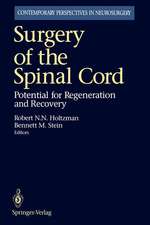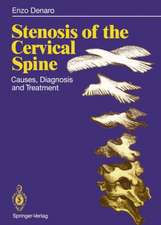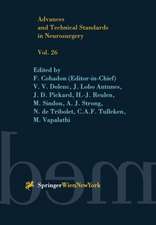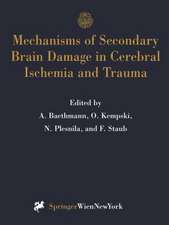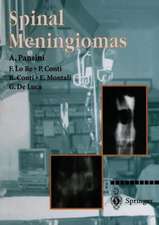Tuning the Brain: Principles and Practice of Neurosomatic Medicine
Autor Jay Goldsteinen Limba Engleză Paperback – 16 ian 2004
From the author: “For many years I have viewed brain function as a system of electrochemical impulses continually flashing through the brain. These neural networks can often be modulated fairly simply by ’tuning’ them. The point I have been trying to make for many years is that this process may be pharmacologically regulated extremely rapidly in a manner which does not yet seem to be recognized by the medical profession.”
In this remarkable volume, Dr. Jay A. Goldstein clearly presents both the theoretical and the practical aspects of his revolutionary approach to treating CFS and other conditions that have often been termed psychosomatic. Dr. Goldstein (author of Chronic Fatigue Syndromes: The Limbic Hypothesis and Betrayal by the Brain: The Neurologic Basis of Chronic Fatigue Syndrome, Fibromyalgia Syndrome, and Related Neural Network Disorders) shows how he achieves results for patients with CFS and a variety of other syndromes in days, rather than months or years.
This well-referenced book answers questions, from the most basic to the most complex, including:
- What is neurosomatic medicine?
- How did Dr. Goldstein come to pioneer and practice this specialty?
- What abnormalities in brain function produce neurosomatic disorders?
- How can an understanding of these abnormalities help you provide effective treatment?
- Why do these treatments sometimes work so rapidly?
- What is receptor profiling, and how does it indicate the type of receptor dysregulation in an individual patient?
In Part II: Society for Neuroscience Conference Proceedings, the author shares his expertise to bring you experimental results and “pearls of wisdom” relating to neurosomatic medicine from the 28th and 29th Annual Meetings of the Society for Neuroscience—the largest and most important neuroscience conference in the world. Dr. Goldstein sorted through thousands of experiments presented at the conferences to bring you the most relevant findings.
Part III: Pathophysiology and Treatment is essential reading for anyone planning to practice neurosomatic medicine. In this section, richly illustrated with over 70 pages of color figures and diagrams that make complicated concepts clear, Dr. Goldstein shares his knowledge about dozens of the agents he uses to help CFS sufferers and others manage their pain, fatigue, and other symptoms. This is information that simply cannot be found anywhere else, and will prove invaluable to all fledgling neurosomatic practitioners.
This one-of-a-kind volume is thoughtfully put together—from the extensive list of abbreviations near the beginning to the exhaustive references and an appendix with diagnostic criteria, a treatment algorithm, a medication list of treatment options available now or in the near future, and a checklist of CFS symptoms.
Preț: 400.90 lei
Preț vechi: 536.71 lei
-25% Nou
Puncte Express: 601
Preț estimativ în valută:
76.72€ • 83.31$ • 64.45£
76.72€ • 83.31$ • 64.45£
Carte tipărită la comandă
Livrare economică 22 aprilie-06 mai
Preluare comenzi: 021 569.72.76
Specificații
ISBN-13: 9780789022462
ISBN-10: 078902246X
Pagini: 662
Dimensiuni: 148 x 210 x 41 mm
Greutate: 1.36 kg
Ediția:1
Editura: Taylor & Francis
Colecția Routledge
Locul publicării:Oxford, United Kingdom
ISBN-10: 078902246X
Pagini: 662
Dimensiuni: 148 x 210 x 41 mm
Greutate: 1.36 kg
Ediția:1
Editura: Taylor & Francis
Colecția Routledge
Locul publicării:Oxford, United Kingdom
Cuprins
- Foreword
- Preface
- Abbreviations
- Part I: Inventing Neurosomatic Medicine: Rewards and Satisfactions versus Problems and Pitfalls
- Chapter 1. The Education of a Neurosomaticist
- Chapter 2. The Office Practice of Neurosomatic Medicine
- Bankruptcy Despite a Three-Month Waiting List
- Solving the Problems and Avoiding the Pitfalls
- Taking Care of Business
- Chapter 3. Lawyers and Litigation
- Sample Pathophysiology of Posttraumatic Fibromyalgia
- Mene, Mene, Tekel, Upharsin
- Chapter 4. Treatment Case Examples
- Instantaneous Neural Network Reconfiguration by Pharmacologic Modulation of Afferent Cranial Nerve Input
- The Pathophysiology of CFS and Related Neurosomatic Disorders
- Thyroid Function in Neurosomatic Disorders: Stimulation of Trigeminal Nerve Activity with Thyrotropin-Releasing Hormone (TRH)
- Chapter 5. Case Reports
- My So-Called Illness: Is It Real or All in My Head?
- One-Second Epiphanies
- My Most Unusual Case
- Bug-of-the-Month Club
- Chapter 6. Married to a Doctor Who Is Married to His Practice
- Part II: Society for Neuroscience Conference Proceedings
- Chapter 7. This Is . . . Los Angeles
- Chapter 8. Neurosomatic Pearls
- Eldritch Lore About Neurosomatic Therapy
- Chapter 9. Neurosomatic Neuroscience
- Part III: Pathophysiology and Treatment
- Chapter 10. Treatment of Neurosomatic Disorders
- Abecarnil and Acamprosate
- Stimulants
- The Corticostriatal-Thalamocortical (CSTC) Circuit in Reverse
- Corticotropin-Releasing Hormone (CRH) and Hypocortisolism
- Agmatine
- Cholinesterase Inhibitors
- Ascorbate (Vitamin C)
- Amantadine
- Adenosine
- Baclofen
- Gamma-Aminobutyric Acid (GABA)
- Adenosine Triphosphate (ATP)
- Lorazepam Nasal Spray
- Antibiotics
- Endothelin (ET)
- Respiratory Rhythm Regulation in Fibromyalgia Syndrome
- pH and Panic Disorder
- Buspirone/BuSpar
- Thalamic Reticular Nucleus
- The Attentional Network
- Clonidine
- Catecholamines
- Norepinephrine, Dopamine, Salience, and Attention
- Dopamine and Reward
- Effexor (Venlafaxine)
- Synaptic Plasticity and Long-Term Potentiation in Neurosomatic Disorders
- The Postreceptor Phosphorylation Cascade
- The Treatment of Attentional Disorders
- Instantaneous Neural Network Reconfiguration
- Other Aspects of Synaptic Plasticity
- Hormonal Modulation in Neurosomatic Medicine
- Modulating the N-Methyl-D-Aspartate (NMDA) Receptor
- Atypical Messengers
- Synaptic Fatigue
- Glutamate Receptors, Subunits, and Synaptic Scaling
- Neurotrophic Factors
- Metabotropic Glutamate Receptors
- Conclusion
- Chapter 11. Modulating Glutamatergic Neurotransmission
- Ketamine
- Pharmacologic Modulation of Sensory Integration via the Trigeminal Nerve
- Electroconvulsive Therapy (ECT)
- Kinases and Phosphatases
- The Nicotinic Cholinergic Receptor
- Long-Term Potentiation and Depression
- Mitogen-Activated Protein Kinases (MAPKs)
- Gabapentin
- Zolpidem
- Lamotrigine
- Pentazocine (Talwin)
- Oxytocin
- Opioids
- Oxytocin, Hypothalamic Function, and Circadian Rhythms
- Other Effects of Oxytocin
- Modafinil (Provigil)
- Ventrolateral Preoptic Nucleus (VLPO)
- Lidocaine
- Gonadotropin-Releasing Hormone (GnRH) and Dysregulation of Circadian Rhythms
- Pyrrolidines
- Fatigue
- Sleep
- Conclusion
- Conclusion. Closing the Circuit: The Role of the Nucleus Accumbens in Neurosomatic Disorders
- Appendix
- Diagnostic Criteria from the DSM-IV-TR
- Treatment Algorithm
- Medication List: Present and Near-Future Treatment Options for Neurosomatic Disorders
- CFS Symptom Checklist
- References
- Index
Descriere
In this remarkable volume, Dr. Jay A. Goldstein clearly presents both the theoretical and the practical aspects of this revolutionary approach to treating CFS and other conditions that have often been termed psychosomatic. Dr. Goldstein will show you how he achieves results for patients with CFS and a variety of other syndromes in days, rather than months or years. From the most basic questions—”What is neurosomatic medicine?” and “How can treatments sometimes work so rapidly?”—to specific technical concerns—”What is receptor profiling, and how does it indicate the type of receptor dysregulation in an individual patient?”—Tuning the Brain: Principles and Practice of Neurosomatic Medicine provides the answers in a clear and cogent manner. You'll learn which abnormalities in brain function produce neurosomatic disorders and how an understanding of these abnormalities can help you provide effective treatment.


